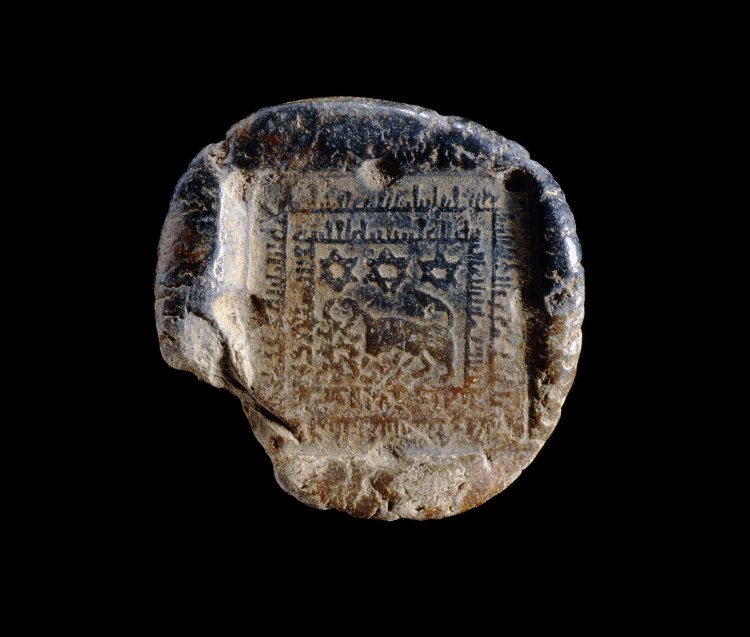
© The Trustees of the British Museum
The inhabitants of the Arabian peninsula have a long history with their neighbours in the land of Egypt. Herodotus tells us about a garrison of Arab soldiers stationed at Elephantine in southern Egypt, a claim perhaps confirmed by Arab names in fifth-century BCE papyri from the city. Arabs later appear in Ptolemaic and Roman papyri in professions as diverse as barber, farmer, and gymnasiarch (magistrate of a culturally-Greek city). But Egypt’s relationship to the Arab peoples was transformed with the development of Islam in the early seventh century CE, as the Prophet Muhammad (ca. 570-632) forged a new state in the Arabian Peninsula, founded upon a monotheistic religion which understood itself as the successor to the Jewish and Christian revelations.
In 634, this new Islamic caliphate captured Roman Syria, forcing the emperor of the Eastern Roman (or “Byzantine”) empire to flee to his capital of Constantinople, and leaving Egypt relatively undefended. The Arab armies arrived in Egypt in 639, led by ‘Amr ibn al-‘As, who, according to later histories, knew Egypt well from his previous life as a merchant. The Roman state, weakened by over a hundred years of war with the Persian Empire, was unable to effectively defend Egypt, and in 641 CE, Cyrus, the Patriarch of Alexandria, enraged the Roman Emperor by surrendering the province to ibn al-‘As.
The later Christian and Muslim histories, written in the ninth century CE onwards, stress the divisions that existed in Egypt at the time of the conflict. The majority of Egyptians belonged to the miaphysite church, but the Roman Emperor had, since the Council of Chalcedon in 451 CE, supported the dyophysite church, the ancestor of the modern Roman Catholic and Greek Orthodox churches. What might seem like an inconsequential argument over the nature of Christ – did he have a single nature, equally human and divine (miaphysite), or two separate natures, human and divine (dyophysite) – had created a deep schism, two parallel churches and two patriarchs of Alexandria, co-existing, but not necessarily peacefully. Later histories recount the persecution of the Miaphysite Church by the dyophysite emperors and their representatives, and suggest that many of the Egyptians saw the Muslims as divine punishment upon their heretical oppressors, and may even have helped the Muslim conquerors in order to be free of the Roman empire. Mighad Mikhail has pointed out that earlier sources do not necessarily support this narrative, however: the patriarch who surrendered Egypt, Cyrus, was the head of the dyophysite Melkite (“Imperial”) Church in Egypt, and while it seems that the Muslim army may indeed have received help from Egyptians, support likely came from members of the largely Melkite elite who hoped to keep their wealth and status after the conquest.
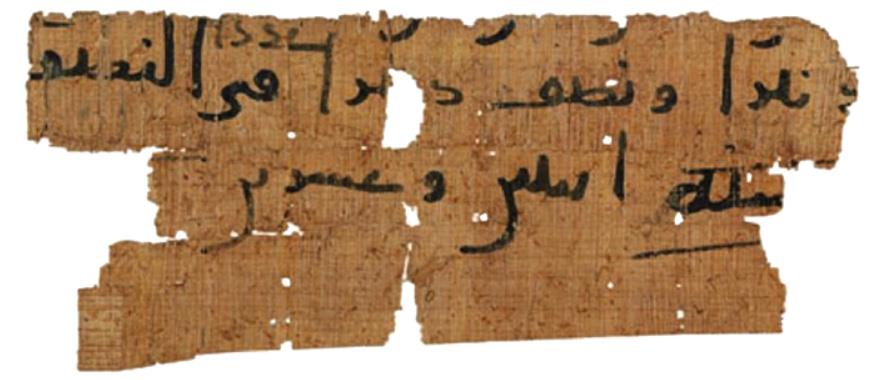
The Arabs called Egypt Miṣr, an old name for the country with parallels in other Semitic languages such as Akkadian and Hebrew, but they used a different name for the Christian inhabitants of Egypt, qubṭ. This was borrowed from the Greek name for the country, Aigyptos, the origin of the English word “Egypt”, and itself probably derived from Hikuptaḥ, one of the Egyptian names for Memphis, the ancient capital city. As we have noted, the majority of the Egyptian population belonged to the miaphysite church, which actually grew in power after the Islamic conquest as it absorbed Christians from other sects – Melkites, but also smaller, barely-remembered groups such as the Akephaloi, Eutychians, Julianists and Barsanuphians. This close association between Egyptian Christians and the miaphysite church meant that the word qubṭ began to be used to differentiate the miaphysites from the Melkites, so that when Western Europeans encountered them during the Middle Ages they borrowed the Arabic word to distinguish the Egyptian miaphysites from the other Christians they encountered, referring to them in Latin as copti. This is the origin of the modern name for the Coptic Orthodox Church and its liturgical Coptic language in the European languages; Coptic refers to itself simply as “Egyptian” (mnt-rm-n-kēme).
The Arab conquest, like the Roman and Macedonian conquests before it, was to have profound effects on Egyptian history, which we can only describe very briefly here. Egypt found itself part of a new Islamic world, and would belong to several larger Islamic empires over the centuries, each with its own particularities. The early Umayyad dynasty (661-750 CE), for example, is often seen as an ethnically Arab kingdom, which discouraged the conversion of its subjects to Islam, subjecting converts to the same poll tax (jizya) as the non-Muslim Christian and Jewish populations. In Egypt, they tended to keep much of the Roman administration in place, continuing to use Greek as an administrative language, and relying on the Christian elites to govern and collect taxes. By contrast, their successors the ‘Abbasids (ruled Egypt 750-969 CE) treated all Muslims equally, regardless of their ethnic origins, and implemented an administration based on the Persian system of their heartlands in modern Iran. Throughout these, and later dynasties, however, policies changed considerably depending on the caliph and governor, and many of the changes seen in the ‘Abbasid period seem to have already begun in under the Umayyads.
The Arabisation and Islamicisation of Egypt – two processes of transformation, took place very gradually. “Arabisation” refers to the adoption of Arabic language and culture, both of which would have allowed Egyptians of all faiths greater social mobility, allowing them to participate in the wider Arabic culture and administration. Christian texts from tenth- and eleventh-century Egypt show a concern that knowledge of the Coptic language was declining, and we can see a marked example of this in the decision of the Coptic Patriarch Christodoulos (reigned 1047-1077) to write a series of church canons (laws) in Arabic rather than Coptic or Greek. Coptic seems to have ceased to be a living written language around 1300, the approximate date of the last documentary texts, and of the last major literary composition, the Triadon. While Coptic likely survived as a spoken language in some parts of Egypt for centuries, it was increasingly a language of religion, which had to be formally studied by the clergy, much like Latin in Western Europe. To facilitate this, Coptic writers of the thirteenth and fourteenth centuries such as Yūḥannā al-Samannūdī began to produce grammars of the Coptic language – the first known grammars produced in any stage of Egyptian – essentially laying the groundwork for modern Coptology.
Islamicisation – the conversion of the Christian and Jewish populations of Egypt to Islam – was another gradual process, which is still only partially understood, although it happened much more slowly than the earlier Christianisation. Christians had existed in Egypt for over two hundred years when the Emperor Constantine ended the persecution of Christians in 313 CE, and in less than a hundred years Christians were a majority and “pagan” cultic practices had been outlawed. By contrast, Islam was a new arrival in Egypt, and the Muslim rulers considered Christians a protected minority. Forced conversion seems to have been rare, and while non-Muslims faced some disadvantages, such as having to pay the poll tax, persecution seems to have been sporadic, and focused on the ecclesiastical and secular elites, who might occasionally face sudden tax burdens or expulsions from the administration, depending on the particular ruler. While converts to Islam might at times gain certain advantages – increased social mobility and freedom from the poll tax – they also may have faced ostracism from their Christian family and friends. This would only have changed gradually, as the numbers of converts slowly grew, and as Muslim Arabs settled and began to live alongside Christians, narrowing the divide between the two communities. While some Egyptians probably converted to Islam in the decades following the invasion, the Umayyad policy of discouraging conversion meant that the first significant conversions took place in the eighth century, and most historians agree that Christians remained a majority until at least the end of the ninth century, a picture confirmed by Muslim visitors to Egypt at this time. It is likely not until the fourteenth century, with the Mamluk Sultanate (1250-1517), that Christians in Egypt became a clear minority, as they remain up to the present day. The rulers of this dynasty, converted slaves of non-Muslim origin, presented themselves as champions of the faith, and periodically passed or enforced laws limiting the freedoms of non-Muslims, increasing taxes arbitrarily, demolishing churches, and occasionally even forcing the conversion of Christian members of the administration.
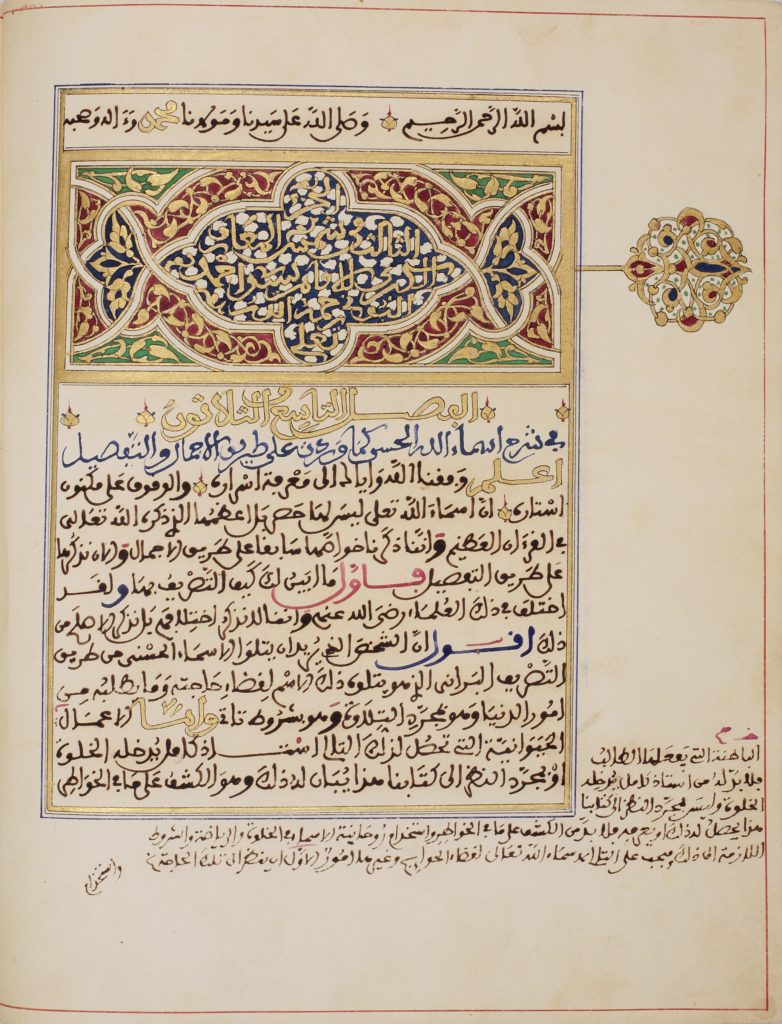
Image © 2016 Khalili Collections.
But what happened to magical practices through all these political, religious and linguistic changes? Arabic language texts appeared in Egypt almost immediately after the conquest, and some of these preserve an early Muslim magical tradition. Later Arabic works, including the famous tenth-century “Goal of the Sage” (Ġāyat al-Ḥakīm, translated into Latin as the Picatrix) and the writings of the thirteenth-century Cairene al-Buni, contain complex magical systems which drew upon pre-Islamic Graeco-Egyptian and Indian practices. These texts strongly influenced mediaeval Western scholars, who translated Arabic magical texts as eagerly as they did mathematical, philosophical or astrological works in Arabic. The earliest texts from Egypt, however, tend to be small amulets containing verses from the Quran or lists of the names of God, offering a parallel to the Christian practice of using Biblical verses for protection.
Some recently published texts show that Arabic-language magic was adopted by Christians surprisingly early – an amulet in the form of an ostracon inscribed with a Muslim prayer has been found in an eighth-century monastery, and in a Coptic letter from the same period a Christian sends an amulet attributed to a Muslim sage to heal a woman from sickness. Muslim influence in Coptic language magical texts appears somewhat more slowly, though; it may be that practitioners writing in Coptic were more conservative. But from the ninth-century or so, we do begin to see the influence of both Arabisation and Islamicisation in our material.
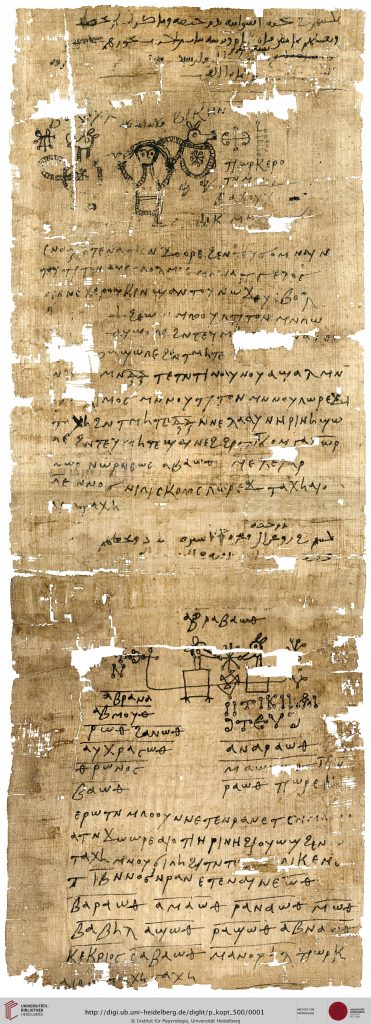
One clear example of this is in the use of Arabic loanwords; the dominance of the Arabic language in technical fields such as medicine, mathematics and astronomy seems to have extended to magic, and late Coptic magical texts often use Arabic words for ingredients. P. Heid. Kopt. Inv. 685, dating to the late tenth century, instructs the user to write an amulet using al-zaʿfarān (“saffron”), wine and al-ma’warad (rose-water).
Another example of the Arabisation of Coptic magic is found in a few texts which mix the Coptic and Arabic languages. In P. Heid. Inv. 500 + 501 (9th century CE ?), a series of Coptic spells are accompanied by instructions for their use in Arabic, implying that their user, likely a Christian, had inherited, and wanted to use, Coptic-language magic, but felt more comfortable reading instructions in Arabic.
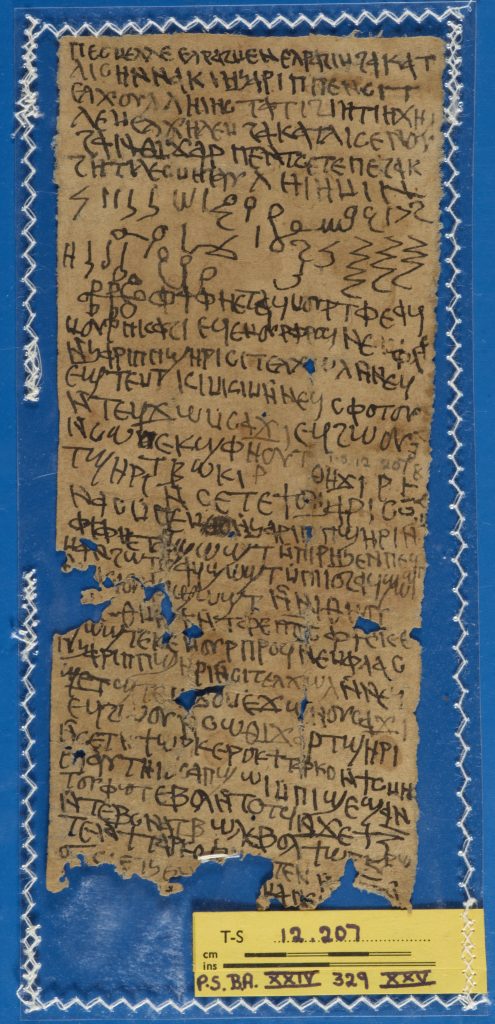
The most striking example, though, is found in Cambridge University Library T-S 12.207, one of a handful of Coptic texts said to come from the Cairo Genizah; although the unusual handwriting makes it difficult to date, it is unlikely that it is older than the tenth century. Written in Coptic script, this is a binding curse intended to silence a man named Charip for the benefit of a woman named Thijar. Perhaps Thijar was facing Charip in court, or had been slandered or threatened by him, and needed supernatural help to fight back. This text was folded into a small parcel, and a short text, including several crosses, was written on the small part that was left visible.
What is astonishing about this text is that the first part of the curse begins with the Islamic basmala, the invocation of the name of God, used throughout the Quran and in Muslim prayers:
In the name of Allah, the All-Beneficent, the All-Merciful! Bind the tongue of Charip, son of Sitt al-Kull, that he may longer be able to speak a word. Binding of his tongue on behalf of Thijar, daughter of Sete, through the power of these names. Amen.
T-S 12.207 ll.1-6
What is even more astonishing though is that this whole first section is written in the Arabic language, but written in Coptic script. Whoever first wrote it knew Arabic, but wanted to use the Coptic alphabet, perhaps because it seemed more exotic and magical. This section is followed by the “names”, written in the indecipherable magical signs known as charaktēres, before continuing with a section which is written not just in the Coptic script, but also in the Coptic language:
God, he who bound the heaven and the earth, may he bind the mouth and the tongue of Charip son of Sit al-Kull, that he may not be able to move his lips to say an evil word…
T-S 12.207 ll.7-11
This text – a bilingual Arabic-Coptic curse, apparently found in a Jewish synagogue, raises important questions about the relationships between the different religious communities in Cairo. Was this the work of a Coptic “magician”, whose religion and language made him all the more impressive to a Muslim or Jewish client? Or did a Jewish or Muslim practitioner learn Coptic so that they could write a spell in the ancient Egyptian language? And how did this text end up in the Cairo synagogue? Perhaps more work on the history of this text, and the names of the individuals it mentions, will reveal further secrets, but for now it remains a tantalising reminder of the intertwined religious and magical traditions of mediaeval Egypt.
*I would like to thank Naïm Vanthieghem for offering comments and corrections to a draft version of this post, and to and Sebastian Richter for providing unpublished material. Any mistakes which remain are my own.
Bibliography and Further Reading
Bilabel, Friedrich, and Adolf Grohmann. Griechische, koptische und arabische Texte zur Religion und religiösen Literatur in Ägyptens Spätzeit, Heidelberg: Verlag der Universitätsbibliothek, 1934, no. 123, pp. 328-344.
The publication of P.Heid.Inv. 500 + 501, the large bilingual Arabic-Coptic magical text.
Bulliet. Richard W. Conversion to Islam in the Medieval Period: An Essay in Quantitative History. Cambridge: Harvard University Press. 1979.
Crum, Walter E. “A Bilingual Charm.” Proceedings of the Society of Biblical Archaeology 24 (1902): pp. 329-331. URL
Crum, Walter E. “A Bilingual Charm.” Proceedings of the Society of Biblical Archaeology 25 (1903): pp. 89. URL
These two articles contain the publication of Cambridge University Library T-S 12.207, the bilingual Coptic-Arabic text from the Cairo Genizah discussed above.
El Daly, O. Egyptology: The Missing Millennium. Ancient Egypt in Medieval Arabic Writings (London: UCL Press, 2005).
Garel, Esther. “Lettre concernant l’envoi d’un papyrus iatro-magique et une réquisition de laine de mouton (P.Vindob. Inv. K 55)”. Journal of Coptic Studies, 18, (2016): 45-55.
The publication of a Coptic letter discussing the use of a book containing magical healing recipes in Arabic.
Kennedy, H. “Egypt as a Province in the Islamic Caliphate, 641-868”, in Cambridge History of Egypt, vol.1. Islamic Egypt, 640-1517, edited by C. F. Petry. (Cambridge: Cambridge University Press, 1998): 62-85.
Little, Donald P. “Coptic Conversion to Islam under the Baḥrī Mamlūks, 692-755/1293-1354”. Bulletin of the School of Oriental and African Studies, University of London 39.3 (1976): 552-569.
MacDonald, M.C.A. “Arabs, Arabias and Arabic before Late Antiquity”, Topoi 16.1 (2009): 277-332.
Meyer, Marvin W. The Magical Book of Mary and the Angels : (P. Heid. Inv. Kopt. 685) : text, translation and commentary. Heidelberg : Universitätsverlag C. Winter, 1996.
The publication of P. Heid. Inv. Kopt. 685, a Coptic magical text containing many Arabic loanwords.
Mikhail, Maged S. A. “An Orientation to the Sources and Study of Early Islamic Egypt (641–868 CE)”. History Compass 8.8 (2010): 929-950.
Mikhail, Maged S. A. From Byzantine to Islamic Egypt : Religion, Identity and Politics after the Arab Conquest (London/New York : I.B. Tauris, 2016).
Papaconstantinou, Arietta. “Between Umma and Dhimma: The Christians of the Middle East under the Umayyads”. Annales Islamologiques 42 (2008): 127–156.
Poter, Venetia, Liana Saif and Emilie Savage-Smith. “Medieval Islamic Amulets, Talismans, and Magic”. In A Companion to Islamic Art and Architecture, edited by Finbarr Barry Flood and Gülru Necipoǧlu (John Wiley & Sons, 2017): 521-557. URL
Sijpesteijn, Petra M. “The Arab Conquest of Egypt and the Beginning of Muslim Rule”. In Egypt and the Byzantine World 300-700, edited by Roger S. Bagnall. (Cambridge, Cambridge University Press: 2007): 437-457.
Sijpesteijn, Petra M. Shaping a Muslim State: The World of a Mid-Eighth-Century Egyptian Official (Oxford: Oxford University Press, 2013).
Richter, Tonio Sebastian. “Borrowing into Coptic, the Other Story. Arabic Words in Coptic Texts”. In Greek Influence on Egyptian-Coptic: Contact-Induced Change in an Ancient African Language, edited by Eitan Grossman, Peter Dils, Tonio Sebastian Richter and Wolfgang Schenkel (Hamburg: Widmaier Verlag: 2017), 513-533.
Richter, Tonio Sebastian. « Greek, Coptic, and the ‘Language of the Hijra’. Rise and Decline of the Coptic Language in Late Antique and Medieval Egypt », dans From Hellenism to Islam: Cultural and Linguistic Change in the Roman Near East, éd. H. Cotton, R. Hoyland, J. Price et D. J. Wasserstein, Cambridge UP, 2009, p. 402-446.
Swanson, Mark N. The Coptic Papacy in Islamic Egypt (641-1517) (Cairo: American University in Cairo Press, 2010).
Vanthieghem, Naïm. “Magie arabe dans l’ermitage d’un prêtre copte du VIIIe siècle”. Journal of Coptic Studies18 (2016): 181–184. URL
The article containing the publication of an Arabic amulet from a Christian monastery.
